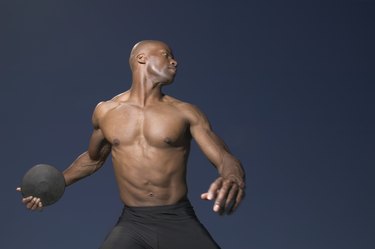
When you think of an athlete, more than likely a well-developed muscular image comes to mind. But, it may surprise you to hear that an athletic body is not necessarily what exercise and fitness experts have in mind when they speak of a fit body. Athletes come in all sizes and shapes, and in some sports, a successful participant is not what you might initially envision.
Athletes Come In All Sizes
Video of the Day
Not all athletes fit a textbook description or definition of a fit body. If you have any doubts, simply take a look at a heavyweight Olympic power-lifter, a few of the many football linemen or even a sumo wrestler. Although each of these athletes may be extremely successful in their sport, their athletic body type is what health and fitness experts might say classify them as having overweight or obesity.
Video of the Day
What Is a Fit Body?
Fitness is defined in a way that incorporates but also transcends the mere outward appearance of the body. While a body that contains too much body fat may not always be so obvious to the eye, in most instances, it is. Body composition -- or the ratio of body fat to lean tissue -- is one measure of a fit body. Body fat measurements that fall outside of recognized norms are indicators of an unfit body.
Attributes of an Athletic Body
Depending on the sport played, the athletic body is built and trained for strength, power, speed, agility, quickness, endurance or a combination of these attributes. But an athletic body that is built, for instance, for an endurance sport such as marathon racing may be severely limited when it comes to strength -- particularly in the upper body, or even flexibility. While some sports, such as gymnastics may require the athlete to be proficient in most if not all of these attributes, others have more very specific requirements and therefore the body type of the athlete performing them may not be as well-rounded. An athlete's body type more often than not reflects the most commonly relied upon skills needed for their sport -- for example, again think of a sumo wrestler.
A Fit Body Meets These Five Criteria
Fitness professionals will tell you that to have a truly fit body requires that you meet or exceed the published norms in five different physical components. These components are flexibility, cardiovascular fitness, body composition, muscular strength and muscular endurance. Norms for these five components are published by such organizations as the YMCA and the American College of Sports Medicine. Because of this textbook definition of a fit body, a fit body and an athletic body can be, but may not be the same thing.
Which Is Best?
Deciding which body type is best for you requires that you take a critical look at your purpose for building the body you seek. If you're playing a specific sport that requires very specific physical attributes, then by training or simply by playing the sport itself you will begin to build the athletic body that you need. If, however, your goal is to have a fit body, a great starting point is a fitness assessment in which you will be tested in the five components of fitness, and your results will guide you as to what areas you need to work on to achieve the body you want.